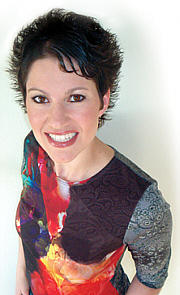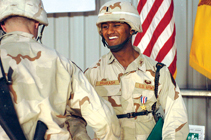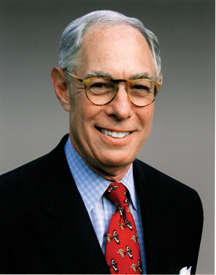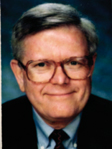






 |
||||
 |
 |
 |
 |
 |
 |
||||
|
J U N E 2 0 0 5 Alumni News
Editor: Philip Tang, A&S '95 | |
|
For more alumni info visit alumni.jhu.edu
Follow this link to
Send email to |
Liz Witts, Peab '95: "When in Doubt, Throw it Out" Six years ago, Liz Witts had a 20-month-old son and twins on the way. Faced with impending chaos, she needed a survival plan — and fast. So she decided to get organized; keeping her Montgomery County, Pennsylvania, home in order made Witts' life a lot less stressful. "My friends started telling me I should make a career out of this," Witts recalls, "and I would ask, 'a career out of what?' I thought everyone knew how to organize. It felt like common sense to me."
Witts soon realized that organizing does not come naturally
to everyone — and that many of her organizationally
challenged friends and neighbors were willing to pay her to
get their clutter under control. She launched her company,
Simply Organized, in 2002 and quickly developed a steady
and growing base of clients before landing an interview
with the Home and Garden Television Network. |
 Professional organizer Liz Witts (below) transformed
this living room from a mess to a masterpiece. "Letting go
of your belongings is all part of the process," she
says.
Professional organizer Liz Witts (below) transformed
this living room from a mess to a masterpiece. "Letting go
of your belongings is all part of the process," she
says.Photos Courtesy of Liz Witts |
 The HGTV producers thought Witts was a natural fit for the network's 30-minute show, Mission: Organization, and added her to the pool of professionals who redesign disorganized living spaces one room at a time, without a script, in front of millions of viewers. Since May of last year, Witts has participated in eight episodes, with another two in the works. She rescued a schoolteacher and her husband from the messiness of their master bedroom. She helped another couple bring order to their home office. And she showed a busy pharmaceutical salesman that organization was the perfect medicine for making his living room more livable. "I really love my work on the show," Witts says. "I've met a lot of wonderful people and improved my skills as well." The filming, shot on location, takes place over the course of a month. Witts also puts in at least 40 hours of work from home — getting to know the family, researching vendors, creating order lists, and redefining the space. She finds herself doing much more than relegating clutter to file boxes; she serves as interior decorator, too, selecting colors and carpets and determining what furniture works best where. Along with her television work, Witts keeps approximately 25 private clients in tiptop organizational shape. Regardless of the task at hand, Witts has never met a mess she couldn't conquer — although she occasionally encounters clients who are not quite ready for her services.
"Letting go of your belongings is all part of the process,"
Witts explains, adding that some clients just can't part
with their clutter. "They have to reach the saturation
point where they're really ready to change." |
 Liz Witts
Liz Witts |
 On or off camera, Witts' busy life as a professional
organizer and mother of three leaves little time to spare.
She plays the flute for her personal enjoyment —
music performance in flute was her major at Peabody —
and gives private lessons. On Sundays, she teaches Hebrew
school in her hometown of Abington, Pennsylvania.
On or off camera, Witts' busy life as a professional
organizer and mother of three leaves little time to spare.
She plays the flute for her personal enjoyment —
music performance in flute was her major at Peabody —
and gives private lessons. On Sundays, she teaches Hebrew
school in her hometown of Abington, Pennsylvania.Witts recently remarried and claims that her husband, Mark, shares her love for organization. "He was organized before I met him," Witts cheerfully confesses. "We both like order, so we're a good match."
Her children may also share Witts' organizational
tendencies. She proudly reports that her twins, now 6 years
old, are often discovered in their bedroom, playing with
three sorting bins labeled "keep," "donate," and "long-term
storage."
Neil Prakesh, A&S '02: Grace — and Leadership — Under Fire Lt. Neil Prakash seems to be taking his Silver Star in stride. "It could have been any platoon leader in that position," says Prakash, 25, who was an ROTC cadet at Johns Hopkins. "I am not a hero. We were just given a mission and told to execute."
Prakash was awarded the medal, one of the U.S. military's
top honors, in January for his superior performance in
combat under enemy fire in a battle in the Iraqi city of
Baqubah. A tank platoon leader from the 2nd Battalion, 63rd
Armor Regiment, Prakash maneuvered his company through a
barrage of grenades and machine gun fire to secure key
bridges in the area and prevent enemy reinforcements. |
 Lt. Neil Prakash receives his Silver
Star.
Lt. Neil Prakash receives his Silver
Star. |
 According to a U.S. Army Web site account of the platoon's
actions, Prakash and his unit were sent into the city of
Baqubah on the morning of June 24, 2004. The crew soon
received reports of enemy activity in the city. "When the
RPGs started flying in from every direction at my tank, I
really didn't have an inkling of what I was caught in,"
Prakash recalls. "I wasn't scared — because I was
just unaware of the volume of enemy fire."
According to a U.S. Army Web site account of the platoon's
actions, Prakash and his unit were sent into the city of
Baqubah on the morning of June 24, 2004. The crew soon
received reports of enemy activity in the city. "When the
RPGs started flying in from every direction at my tank, I
really didn't have an inkling of what I was caught in,"
Prakash recalls. "I wasn't scared — because I was
just unaware of the volume of enemy fire."Prakash's tank took several hits, and its navigation system was destroyed. The platoon was ordered to turn around to establish a defensive block, and Prakash returned to base for tank repairs, the Army reported. His crew then resumed the lead combat position until fighting ended the next morning. Looking back at the incident almost a year later, Prakash says that it was his fellow platoon members who were the "real heroes." "Those brave soldiers watched as my tank was engulfed with enemy fire, and then followed me into that chaos to take back the city," he says.
While on leave from Iraq in April, Prakash married Lt.
Laura Lee Olzacki, A&S '04, a platoon leader stationed at
Fort Hood, Texas. She's scheduled to head to Iraq in the
fall.
Arie L. Kopelman, A&S '60: An Eye (and a Talent) for Luxury When young Arie Kopelman visited the Homewood campus in the mid-'50s, he was considering Johns Hopkins University as a place for his pre-med studies. In 1960, he graduated with a history of art degree. The change of direction set the Boston native on a career path he never previously imagined. In January 1986, he became president and chief operating officer of Chanel, Inc., one of the best-known luxury brands in the world.
During Kopelman's tenure, the privately held French company
— famous for its classic couture and legendary
cologne, Chanel No. 5 — ventured successfully into
accessory categories such as jewelry and watches.
Kopelman's growth strategy for Chanel included remodeling
stores, introducing a popular skin care line, and
broadening Chanel's business base in accessories,
fragrances, and cosmetics. In keeping with his advertising
agency background, Kopelman also upped Chanel's ad budget
by 20 percent. The strategy paid off: Today, the brand
continues to epitomize luxury and fashion. |
 For 20 years, Arie Kopelman served as CEO of
Chanel.
For 20 years, Arie Kopelman served as CEO of
Chanel. |
 As he looks back over his career, Kopelman believes that he
honed his twin instincts toward fine art and leadership at
Johns Hopkins. "My art history fascination began with
Phoebe Stanton," he says of the legendary professor (who
died in 2003). Under the direction of Stanton and Adolf
Katzenellenbogen, who chaired the History of Art
Department, Kopelman's interest turned to art and antiques.
With their guidance, he spent a summer abroad, studying art
in Austria. That was good training for what became his
life's work.
As he looks back over his career, Kopelman believes that he
honed his twin instincts toward fine art and leadership at
Johns Hopkins. "My art history fascination began with
Phoebe Stanton," he says of the legendary professor (who
died in 2003). Under the direction of Stanton and Adolf
Katzenellenbogen, who chaired the History of Art
Department, Kopelman's interest turned to art and antiques.
With their guidance, he spent a summer abroad, studying art
in Austria. That was good training for what became his
life's work."Mine is not a job just about number crunching," Kopelman says. "You need to have a certain feel for the luxury goods business."
After graduating from Johns Hopkins, Kopelman received an
MBA from Columbia University School of Business and became
a brand manager for Procter & Gamble. He joined the
advertising firm Doyle, Dane, Bernbach, where he eventually
served as vice-chairman and general manager before being
recruited by Chanel, one of the firm's biggest clients. He
likes to joke that his path to Chanel was aided by
coincidence, noting that his wife Coco shares the name of
Chanel's famous founder. |
 Kopelman's growth strategy included remodeling stores,
introducing a popular skin care line, and broadening
Chanel's business base in accessories, fragrances, and
cosmetics.
Kopelman's growth strategy included remodeling stores,
introducing a popular skin care line, and broadening
Chanel's business base in accessories, fragrances, and
cosmetics. |
 In December 2004, Kopelman stepped down from the top
position at Chanel — but not out of the limelight. In
April, at the Fragrance Foundation's annual awards —
the "Oscars" of the fragrance industry — longtime
friend and Bloomingdale's chairman and CEO Michael Gould
presented Kopelman with the foundation's Hall of Fame
Lifetime Achievement Award for his outstanding
contributions to the fragrance, beauty, and fashion
industries. Past honorees include Estée Lauder and Oscar de
la Renta.
In December 2004, Kopelman stepped down from the top
position at Chanel — but not out of the limelight. In
April, at the Fragrance Foundation's annual awards —
the "Oscars" of the fragrance industry — longtime
friend and Bloomingdale's chairman and CEO Michael Gould
presented Kopelman with the foundation's Hall of Fame
Lifetime Achievement Award for his outstanding
contributions to the fragrance, beauty, and fashion
industries. Past honorees include Estée Lauder and Oscar de
la Renta.Kopelman has not left Chanel altogether — he now holds the title of vice-chairman of the board. With his new semi-retired status, Kopelman has even more time to devote to the art and architecture-related volunteerism that has occupied his off-hours, from his role as past president of the Nantucket Historical Association's Board of Trustees to his ongoing chairmanship of the Winters Antiques Show, an annual New York event that benefits the East Side House Settlement.
Kopelman has not turned his nose up at fine fragrance,
however. He's onto a new scent — one that can't be
captured in a bottle: "It's time for me to start smelling
the flowers," he says.
Chirag Patel, Engr '01, '04 (MS): "Involved" on a Whole New Level When Chirag Patel came to Johns Hopkins in summer of 1997, he was less than satisfied with his first campus volunteering experience: Though the freshman group was assigned to clean up an historic house on St. Paul Street, no one at the site was there to let them in.
"Basically we got there and ate lunch outside on the
ground," he says. |
 While at Johns Hopkins, Chirag Patel even dedicated his
summers to volunteer work. Here, he installs a swing seat
in a dilapidated Baltimore City playground.
While at Johns Hopkins, Chirag Patel even dedicated his
summers to volunteer work. Here, he installs a swing seat
in a dilapidated Baltimore City playground.
|
 So Patel spent the next two years transforming what was an
unstructured day of service for new students into an
organized annual event — now called Involved —
that introduces freshmen to Baltimore neighborhoods through
community service projects.
So Patel spent the next two years transforming what was an
unstructured day of service for new students into an
organized annual event — now called Involved —
that introduces freshmen to Baltimore neighborhoods through
community service projects.Last January, Patel, 25, was recognized for his work when the National Child Labor Committee presented him with the prestigious Lewis Hine Award. Patel was among 10 award recipients selected from across the country. Previous winners include Oprah Winfrey, Hillary Clinton, and Harry Belafonte. "It was a great surprise," Patel says of the award, which carries a prize of $1,000. (He donated the money to the Indian Ocean tsunami relief efforts.) "I felt so honored, but this is really representative of all student volunteers across the nation." To create Involved, Patel solicited donations and worked with student leaders and administrators to develop 27 community service projects for first-year students. Activities included poker games with nursing home residents, painting an outdoor mural with a local artist, and rebuilding a playground. While an undergraduate, Patel also threw himself into volunteer work, teaching ESL through the Greater Homewood Community Association and serving as a Junior Achievement representative at Hampden Elementary School. "He set the standard for those who followed him to continue," says Bill Tiefenwerth, director of the Johns Hopkins Center for Social Concern, recalling how Patel turned one day of service into "a challenge to first year students to become involved over the next four years." "What Chirag really did was to look for activities that had a deeper meaning," says Tiefenwerth, who Patel describes as a mentor, "working side by side with the community rather than doing the clean-up days that they did in the past." Now an MD and PhD candidate at the University of Texas Health Science Center at Houston, Patel's commitment to service remains strong. He is involved in planning school-sponsored "United to Serve" days in the Texas Medical Center and volunteers regularly at a health care clinic for the homeless.
"It's just a passion that I have," says Patel. "I'm trying
to lend my experience wherever I can."
Rudy Boschwitz, A&S '51, led the U.S. delegation to the 61st session of the United Nations commission on human rights at its 2005 annual meeting in Geneva, Switzerland. Boschwitz, who was a Minnesota senator from 1978 to 1991, was appointed to the position by President Bush. He previously served as President George H.W. Bush's emissary to the Horn of Africa and played a role in Operation Solomon, the 1991 rescue mission that successfully airlifted some 15,000 Ethiopian Jews to Israel in little more than a day. Boschwitz also participated in negotiations that helped end a decades-long civil war in Ethiopia. In March, President Bush appointed R. Nicholas Burns, SAIS '80, undersecretary of state for political affairs, the third highest ranking official in the State Department. As under secretary, he oversees U.S. policy in every region of the world and serves in the senior career foreign service position at the State Department. Burns was most recently the U.S. ambassador to NATO. He has also served as ambassador to Greece, State Department spokesman, and acting assistant secretary for public affairs under secretaries of state Warren Christopher and Madeleine Albright. You Poor Monster, (MacAdam Cage), the new book by Michael Kun, A&S '84, has been nominated for a Pulitzer prize. The novel has also been selected as a Borders "Original Voices" pick and Barnes and Noble "Discover Great New Writers" selection. Kun published My Wife and My Dead Wife in 2004.
|
|
Illustration by Timothy Cook |
 "Our school addresses quality-of-life issues in
communities, and we target some of the most challenging
problems," says Ralph Fessler, dean of the School of
Professional Studies in Business and Education (SPSBE),
describing the school's focus. Founded in 1909 as College
Courses for Teachers, the school has spent almost a century
evolving to meet the needs of changing communities through
teaching, research, partnerships, and community
involvement.
"Our school addresses quality-of-life issues in
communities, and we target some of the most challenging
problems," says Ralph Fessler, dean of the School of
Professional Studies in Business and Education (SPSBE),
describing the school's focus. Founded in 1909 as College
Courses for Teachers, the school has spent almost a century
evolving to meet the needs of changing communities through
teaching, research, partnerships, and community
involvement.
SPSBE covers a lot of ground — academically,
geographically, and numerically — with nearly 4,500
students and 25,000 alumni (second largest in the
university); five different campuses; and four academic
divisions: Business, Education, Public Safety Leadership,
and Undergraduate Studies. Writer Brian Shields sat down
with Dean Fessler to discuss the school, some new
initiatives, and the challenges ahead. |
 Ralph Fessler, dean
Ralph Fessler, dean |
 Creating and sharing knowledge is at the heart of Johns
Hopkins' mission. How does SPSBE contribute?
Creating and sharing knowledge is at the heart of Johns
Hopkins' mission. How does SPSBE contribute?In all of our academic divisions, our highest priority is creating programs and engaging in partnerships with regional corporations, non-profit organizations, and government agencies that address community needs. These needs include improving educational outcomes for students, creating safe neighborhoods, cultivating minority and professional leadership, developing better housing for seniors, and fostering economic stability and growth. In the process of responding to regional needs, we create national and international models for university-community collaboration. For example, our public safety leadership program (PSL) is all about involvement with community and local leadership. However, our PSL graduates take what they learn and apply our model to national and international security issues. Our program lists more than 30 chiefs of police as graduates nationwide, with many other graduates holding high level security positions within the federal government. You've said that SPSBE targets challenging problems facing communities. Can you cite an example? Urban schools — which face many challenges — are having difficulty attracting a new generation of teachers. We have developed a unique program that has had great success in recruiting, preparing, and retaining quality teachers where they are needed most. While the national teacher dropout rate in urban schools approaches 50 percent within the first four to five years, our partnership with Baltimore City has resulted in a nearly 80 percent teacher retention rate. What challenges does the School face as it works to address society's pressing needs? The needs are many and so are the challenges. To begin with, the feedback we have received from the business community is that they want business graduates with strong skills in group leadership, communication, problem-solving, and conflict resolution. We need to continue to be responsive in our curriculum development and in building responsive models that will serve the needs of businesses and non-profit organizations, and this effort can be strengthened through donor support and corporate partnerships. Due to a shortage of space, our education programs are scattered in various campus locations. In order to better serve the growing needs of the region's urban schools and provide resources for faculty, we are creating a home for our education programs in the old Seton High School building adjacent to the Homewood campus — a move that further integrates Hopkins into the community. This will be a signature building for education with state-of-the-art classrooms, learning laboratories, and seminar rooms. This renovation project provides significant opportunities for naming gifts and for friends and alumni to invest in the future of Hopkins' education programs and initiatives. Are there needs particular to the students and faculty? Scholarship funds are always a big issue, especially for working adults. We need to do all we can to provide scholarship support to our students who are teachers, police officers, and career changers. These are professionals who are not typically funded by their employer and, in the case of teachers, may be subject to the phase-out of federal grants. In addition, endowed professorships are a missing piece of our portfolio. Endowed chairs would go a long way in helping with faculty recruitment and retention. Our school has an important role to play in the local and national arena. We look forward to meeting our challenges and creating new programs that benefit our students, faculty, and community.
Emily Shaw, Med '03 (MA)
It doesn't phase Emily Shaw that her teammates are all men.
As captain of the Baltimore Bulldogs — the top-ranked
team in their division of Hockey North America, an adult
ice hockey league — Shaw is focused on going to the
playoffs this month in Toronto. And winning. |
 Emily Shaw: As skilled at body checking as she is at
illustrating. Below left, her rendering of a hip (or coxal)
bone.
Emily Shaw: As skilled at body checking as she is at
illustrating. Below left, her rendering of a hip (or coxal)
bone. |
 Though the hockey league is 99 percent men, "being a woman
in a male-dominated sport is actually a lot of fun," Shaw
says. "It demands that your skills match those of your
competitors, or flat out, you don't get much respect. Guys
really don't expect me to be as strong of a skater or as
aggressive as I am on ice. I have the element of
surprise."
Though the hockey league is 99 percent men, "being a woman
in a male-dominated sport is actually a lot of fun," Shaw
says. "It demands that your skills match those of your
competitors, or flat out, you don't get much respect. Guys
really don't expect me to be as strong of a skater or as
aggressive as I am on ice. I have the element of
surprise."The six-foot-tall Shaw occasionally lifts weights "to make sure everything is there," but she claims that good skating is more important than brute strength. "I'm strong, but muscles don't necessarily get you a good solid check," Shaw says. "Knocking a guy off his skates requires you to be a better skater than your opponent and knowing just where to knock him."
Off the ice, Shaw, a Johns Hopkins-trained medical illustrator, designs 3D anatomical models and digital artwork for Laerdal, a company famous for its "Resusci Anne" CPR training mannequins. Shaw is helping to design cutting-edge simulation technology that recreates the physical sensations of medical procedures for the purpose of training health care providers. She also has her own freelance medical illustration company, www.illustratingmedicine.com. A renaissance woman, Shaw loves the marriage of art and science — almost as much as she loves hockey.
"How often does a girl get the chance to check guys into
the boards?" she asks. "How could I resist a game that
allows me to do that?"
|
 On April 17, alumni and friends visited the newly
re-opened B&O Railroad Museum in Baltimore.
On April 17, alumni and friends visited the newly
re-opened B&O Railroad Museum in Baltimore. |
 Atlanta Chapter
Atlanta ChapterJuly 17 Annual alumni crab feast at Lake Lanier
Baltimore Chapter
Cincinnati Chapter
Cleveland Chapter
Detroit Chapter
New England Chapter
Los Angeles Chapter
New York Metro Chapter
Philadelphia Chapter
Pittsburgh Chapter
St. Louis Chapter
Washington, D.C. Chapter
San Francisco Chapter
Seattle For a comprehensive, up-to-date list of chapter events, visit www.alumni.jhu.edu. |
 |
|
 The Johns Hopkins Magazine |
901 S. Bond St. | Suite 540 |
Baltimore, MD 21231
The Johns Hopkins Magazine |
901 S. Bond St. | Suite 540 |
Baltimore, MD 21231Phone 443-287-9900 | Fax 443-287-9898 | E-mail jhmagazine@jhu.edu |
|